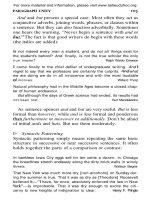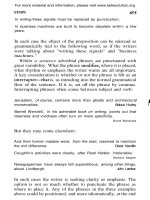Tài liệu Essential guide to writing part 20 pptx
Bạn đang xem bản rút gọn của tài liệu. Xem và tải ngay bản đầy đủ của tài liệu tại đây (304.35 KB, 15 trang )
FIGURATIVE LANGUAGE
The decay of society was praised by artists as the decay of a corpse
is praised by worms. G. K. Chesterton
A simile consists of two parts: tenor and vehicle. The tenor
is the primary in White's the "de-
cay of society" and "artists" in Chesterton's. The vehicle is
the thing to which the main subject is
flies" and the "decay of a corpse" and "worms."
Usually, though not invariably, the vehicle is, or contains,
an image. An image is a word or expression referring to some-
thing we can perceive. "Summer flies," for example, is an im-
age, primarily a visual one, though like many images it has a
secondary perceptual appeal: we can hear the flies as well as
see them.
Vehicle commonly follows tenor, as in the two instances
above. But the vehicle may come emphasizing the main
subject by delay and also arousing our curiosity by
the cart before the horse:
Like a crack in a plank of wood which cannot be sealed, the dif-
ference between the worker and the intellectual was ineradicable
in Socialism. Barbara
Most similes are brief, but they may be
by breaking the vehicles into parts and applying each to the
tenor. A historian, writing about the Italian patriot Garibaldi,
explains that
his mind was like a vast sea cave, filled with the murmur of dark
waters at flow and the stirring of nature's greatest forces, lit here
and there by streaks of glorious sunshine bursting in through crev-
ices hewn at random in its rugged sides.
George Trevelyan
Similes Clarify
Similes have many uses. One is to clarify an unfamiliar idea
or perception by expressing it in familiar terms:
For more material and information, please visit www.tailieuduhoc.org
DICTION
Cold air is heavy; as polar air plows into a region occupied by
tropical it gets underneath the warm air and lifts it up even
as it pushes it back. A cold front acts physically like a
COWCatcher. Wolfgang Langewiesche
Finding familiar equivalents often involves concretion,
which is turning an abstraction into an image readers can
imaginatively see or hear or touch. It has been said, for ex-
ample, that the plot of one of Thomas Hardy's novels is
as complicated as a medieval mousetrap. Virginia
Even though few of us have seen a medieval mousetrap, the
phrase cleverly suggests a labyrinthine Rube Goldberg
contrivance.
Occasionally the process may be reversed so that a simile
abstracts, that is, moves from the concrete to the abstract:
The taste of that crane soup clung to me all day like the memory
of an old sorrow dulled by time. John c. Neihardt
Then the apse [of a medieval cathedral] is pure and beautiful
Gothic of the fourteenth century, with very tall and fluted windows
like single prayers. Hilaire Belloc
Similes can also be emphatic, especially when they close a
sentence or passage, like those by Neihardt and Belloc.
Similes Expand the Subject
Most those whose primary function is to ex-
more than provide a perceptible equivalent of an
abstract idea. Any vehicle comes with meanings of its own,
and these enter into and enlarge the significance of the tenor.
phrase "single prayers" does not help us to see the
windows of the cathedral. But it does enlarge our conception
of those windows, endowing them with the connotations we
For more material and information, please visit www.tailieuduhoc.org
FIGURATIVE LANGUAGE
associate with prayer: the upward lift of the spirit, the urge
to transcend mortal limits.
Here are two other examples of similes rich in implication.
The is about the reminiscences of
old soldiers:
The easy phrases covered the cruelties of war, like sand blowing in
over the graves of their comrades. Thomas Pakenham
The image suggests the capacity of the mind to obscure the
horror of war, even in those, perhaps especially in those, who
endured it.
In this second example the novelist Dinesen is dis-
cussing life on a farm in South Africa:
Sometimes visitors from Europe drifted into the farm like wrecked
timbers into still waters, turned and rotated, till in the end they were
washed out again, or dissolved and sank.
The image implies a great deal about such drifters: their lack
of will and purpose, the futility with which they float through
life, their incapacity to anchor themselves to anything solid,
their inevitable and unmarked disappearance.
Clearly, one advantage of of other as
economy of meaning. Compressing a range of ideas
and feelings into few words, similes deepen prose.
Similes Express Feelings and Judgments
Many similes are emotionally charged. Pakenham's image of
sand blowing over the graves of fallen soldiers, for example,
is heavily freighted with sadness. And in the following figure
the naturalist Rachel Carson does more than describe the
summer sea; she reveals its beauty:
Or again the summer sea may glitter with a thousand moving pin-
pricks of light, like an immense swarm of fireflies moving through
a dark wood.
For more material and information, please visit www.tailieuduhoc.org
" DICTION
Emotional connotations often involve judgments. The poet
Rupert Brooke, writing about a conversation with a salesman,
imagines how the man's mind works:
The observer could see thoughts slowly floating into it, like carp in
a pond.
This simile operates on several levels: it translates an abstrac-
tion (the process of thinking) into an arresting visual image.
It suggests the slowness and ponderousness of this particular
mind. And it implies a judgment, even if humorously: this is
not a mind the writer admires.
One other example, more extended, of a judgmental simile.
The historian Barbara Tuchman is talking about the attitudes
of English Socialists just before World War I:
What was needed was a strong [Socialist] party with no nonsense
and a businesslike understanding of national needs which would
take hold of the future like a governess, slap it into clean clothes,
wash its face, blow its nose, make it sit up straight at table and eat
a proper diet.
Tuchman's image of the bossy nanny nicely conveys the un-
yielding self-righteousness of some Socialists of the
their smug self-assurance, their certainty that they alone knew
what was best for humanity, and their conviction that it was
their duty to impose the truth upon people too childish to
know what was good for them. Fairly or not, Tuchman is
passing judgment. Her mocking image uncovers the disdain
for common people which she senses beneath the Socialists'
reforming zeal.
The judgments implied by such similes are more than so-
ber, objective opinions. The images by which they are deliv-
ered give them great persuasive force. Thus Tuchman plays
upon the resentment we carry from childhood against those
Brobdingnagian know-it-alls who forced us to live by their
rules.
For more material and information, please visit www.tailieuduhoc.org
FIGURATIVE LANGUAGE
Similes Give Pleasure
All good writing gives pleasure. But figurative language is a
special delight. simile, reducing imposing Social-
ists who would reform the world to bossy nannies pontifi-
cating in a nursery, is amusing (whether it is fair is something
else). Here is another example:
There are fanatics who love and venerate spelling as a tomcat loves
and venerates catnip. There are
who would rather parse than eat; specialists in the objective case
that doesn't exist in English; strange beings, otherwise sane and
even intelligent and comely, who under a split infinitive as
you and would suffer under gastroenteritis. H. L. Mencken
Similes Intensify Our Awareness
Finally, beyond their capacity to familiarize the strange, to
expand ideas, to express feelings and evaluations, and to give
us pleasure, similes have an even greater power. They bring
us more intimately in touch with reality by joining diverse
experiences. Think about this description of an old woman's
hands:
Their touch had no substance, like a dry wind on a July
afternoon. Sharon Curtin
Curtin's simile does all the usual a less fa-
miliar to a more familiar one, implies something
about the loneliness of old age, even passes a judgment on life.
But it does more: it unifies perceptions that most of us would
not have put together.
Similes may also cut across the boundaries that separate the
senses:
There was a glamour in the air, a something in the special flavour
of that moment that was like the consciousness of Salvation, or the
smell of ripe peaches on a sunny wall. Logan Smith
For more material and information, please visit www.tailieuduhoc.org
DICTION
In that image two disparate sense perceptions blend into a
experience, and the fused aroma and vision of the
peaches and the sunlit wall connect with the writer's con-
sciousness of religious mystery.
Metaphor
Like a simile, a metaphor is also a comparison. The difference
is that a simile compares things explicitly; it literally says that
X is like Y. A metaphor compares things implicitly. Read
literally, it does not state that X is like Y; but rather that X is
Y:
Cape Cod is the bared and bended arm of Massachusetts.
Henry David Thoreau
Thoreau writes "is," not "is like." However, we understand
that he means the Cape resembles a human arm, not that it
really is an arm. The metaphor has simply taken the compar-
ison a step closer and expressed it a bit more economically
and forcefully.1
A metaphor has the same two parts as a simile:
the main image introduced for
comparison. In sentence the tenor is "Cape Cod"
and the vehicle is "the bared and bended arm." In many meta-
phors both parts are stated. In some, however, the writer re-
fers only to the vehicle, depending on the context to supply
the full comparison. Such a figure is called an implied fused
rather than a full one. Had Thoreau written "the
bared and bended arm of Massachusetts" in a context which
clearly indicated he meant Cape Cod, his metaphor would
have been implied.
1. It is sometimes argued that metaphors are more figures than sim-
iles and even in some ways essentially different. Here we need not assume any
greater virtue in metaphors. They are more economical and generally more
emphatic. For these reasons they are sometimes preferable to similes. But on
some occasions the explicit comparison of a simile is better.
For more material and information, please visit www.tailieuduhoc.org









